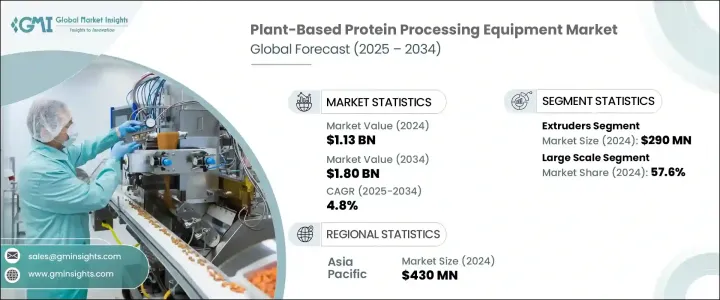
세계의 식물성 단백질 가공 기기 시장은 2024년 11억 3,000만 달러로 평가되었으며 CAGR 4.8%로 성장해 2034년에는 18억 달러에 이를 것으로 추정됩니다.
식물을 전면으로 내세운 식생활, 건강지향의 생활, 지속가능성에 대한 소비자 행동의 변화가 식물성 식품에 대한 수요를 부추겨 콩류와 곡물에서 기능성 단백질을 추출하는 기술에 대한 투자를 촉진하고 있습니다.

대체 식육에 대한 소비자의 관심 증가도 특히 세계 시장에서의 제조 능력의 확대에 영향을 미치고 있습니다. 위생 및 안전기준에 준거한 정밀공학에 근거한 기계가 필요합니다.
| 시장 범위 | |
|---|---|
| 시작 연도 | 2024년 |
| 예측 연도 | 2025-2034년 |
| 시작 금액 | 11억 3,000만 달러 |
| 예측 금액 | 18억 달러 |
| CAGR | 4.8% |
2024년 매출액은 2억 9,000만 달러로 압출 시스템 부문이 가장 큰 점유율을 차지하고 있습니다. 고수분과 저수분 압출 방법에 모두 대응할 수 있는 익스트루더는 스낵, 퍼티, 단백질 강화 제품 등, 폭넓은 식물성 식품 용도에 적응합니다.
2024년에는 대규모 부문이 57.6%의 점유율을 차지했습니다. 이러한 투자는 처리량을 높이고 수작업을 줄이고 전체 생산 일관성을 보장하는 데 도움이 됩니다.
아시아태평양의 식물성 단백질 가공 기기 시장은 2024년 4억 3,000만 달러로, 38%의 점유율을 차지했습니다. 이 지역은 식물성 단백질의 문화적 보급과 왕성한 농업 생산의 양쪽으로부터 혜택을 받고 있습니다. 이를 채용하기 위한 견고한 기반이 형성되고 있습니다. 급속한 산업화가 인구 주도의 식량 수요와 지속가능성에 대한 관심의 높아짐과 함께, 이 지역 전체의 가공기기의 성장을 지지하고 있습니다. 정부의 호의적인 지원과, 식품 혁신과 단백질 조달의 자급 자족을 목표로 한 새로운 대처가, 이 지역 시장 개척을 한층 더 가속시키고 있습니다.
식물성 단백질 가공 기기 업계의 주요 기업으로는 Equinom, Clextral SAS, Hosokawa Micron BV, Alfa Laval, Netzsch-Feinmahltechnik GmbH, Flottweg SE, Bepex International LLC, SPX FLOW Inc, Lyco Manufacturing, Koch Separation Solutions, ANDRITZ AG, Glatt Group, Coperion GmbH, GEA Group, Buhler Group 등이 있습니다. 시장에서의 프레즌스를 확대하기 위해 이 분야의 기업은 연구개발과 첨단 자동화 기술에 대한 전략적 투자를 우선하고 있습니다. 세계 제조업체는 지역화 된 생산 기지와 서비스 네트워크를 통해 신흥 경제권의 발자취를 늘리고 있습니다.
The Global Plant-Based Protein Processing Equipment Market was valued at USD 1.13 billion in 2024 and is estimated to grow at a CAGR of 4.8% to reach USD 1.8 billion by 2034. Shifts in consumer behavior toward plant-forward diets, health-conscious living, and sustainability are fueling demand for plant-based foods, driving investment in technologies that extract functional proteins from legumes and grains. As food producers scale up their operations, they're seeking equipment capable of delivering efficiency, product consistency, and nutritional integrity. These trends are encouraging manufacturers to adopt specialized systems that meet the evolving processing requirements of diverse protein sources.

Increased consumer interest in meat alternatives is also influencing the expansion of manufacturing capabilities, particularly across global markets. However, despite the growing potential, the industry continues to face challenges due to the substantial capital investment needed to establish and maintain commercial-scale plants. Processes like extrusion, drying, fermentation, and texturization demand precision-engineered machinery that complies with strict hygiene and safety standards. For smaller companies, the costs associated with purchasing, installing, and upgrading this equipment often become a major hurdle. In developing regions, limited access to financial support and regulatory infrastructure further intensifies the challenge for new entrants and emerging firms.
| Market Scope | |
|---|---|
| Start Year | 2024 |
| Forecast Year | 2025-2034 |
| Start Value | $1.13 Billion |
| Forecast Value | $1.8 Billion |
| CAGR | 4.8% |
Extrusion systems segment accounted for the largest share in 2024, with revenue of USD 290 million. These systems are essential in shaping textured plant proteins and analogs used in a variety of food applications. They process soy, wheat, and pea proteins into products that replicate the texture and mouthfeel of animal-based foods. With the ability to handle both high- and low-moisture extrusion methods, extruders provide adaptability for a wide array of plant-based food applications including snacks, patties, and protein-enriched products. Their versatility and production efficiency make them a core part of modern processing lines.
In 2024, the large-scale segment held 57.6% share. This growth reflects increased consumer demand for plant-derived proteins and the resulting pressure on producers to deliver consistent output at industrial volumes. Major manufacturers are upgrading their facilities with advanced equipment such as high-capacity dryers, homogenizers, separators, and extruders. These investments help enhance throughput, reduce manual labor, and ensure uniformity across production batches. High-output systems are vital in supporting large brands and retailers that require reliable supply chains for a wide range of protein-based products.
Asia Pacific Plant-Based Protein Processing Equipment Industry generated USD 430 million and held 38% share in 2024. The region benefits from both the cultural prevalence of plant proteins and strong agricultural output. Countries across Asia Pacific have long-standing dietary habits that incorporate soy and legume-based products, creating a solid base for the adoption of plant-based innovations. Rapid industrialization, combined with population-driven food demand and growing concerns about sustainability, are supporting the growth of processing equipment across this region. Favorable government support and new initiatives aimed at food innovation and self-sufficiency in protein sourcing are further accelerating market development in this region.
Major players in the Plant-Based Protein Processing Equipment Industry include Equinom, Clextral SAS, Hosokawa Micron B.V, Alfa Laval, Netzsch-Feinmahltechnik GmbH, Flottweg SE, Bepex International LLC, SPX FLOW Inc, Lyco Manufacturing, Koch Separation Solutions, ANDRITZ AG, Glatt Group, Coperion GmbH, GEA Group, and Buhler Group. To expand their market presence, companies in this space are prioritizing strategic investments in R&D and advanced automation technologies. Many are forming partnerships with food producers and startups to co-develop customized processing solutions that align with new product innovations. Global manufacturers are also increasing their footprint in emerging economies through localized production hubs and service networks. To meet demand scalability, leading firms are launching modular, energy-efficient systems that offer flexibility in handling various plant proteins.